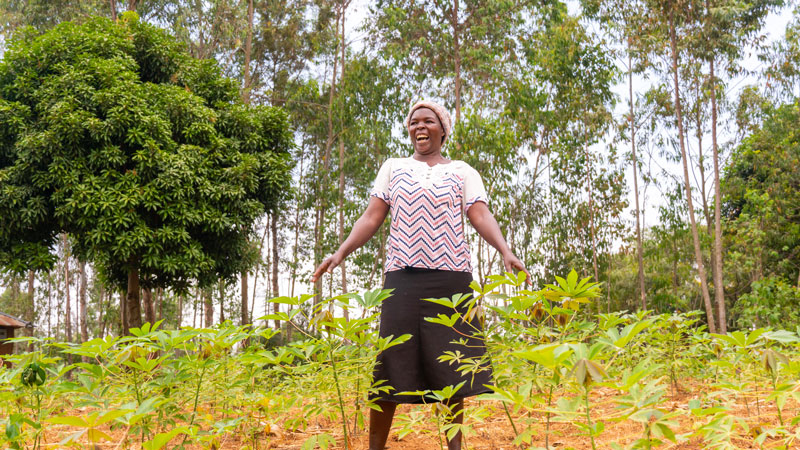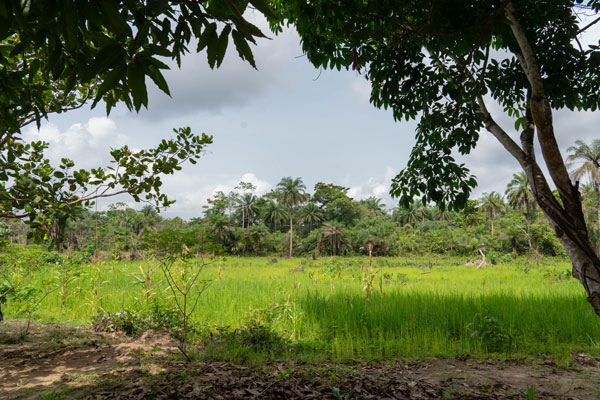

Margret standing in her field in Kisumu County, western Kenya.
This blog was originally published by Terraformation.
By Rachel McMonagle, Program Director, Climate Change at Landesa
Africa has lost almost 40 million hectares of forest over the past decade. This alarming level of deforestation — the highest in the world — threatens the continent and the planet’s future.
African leaders understand the urgency to act and are working together to make ambitious commitments to restore their forests. At the global level, nearly every African country has signed on to the Convention on Biological Diversity (CBD); many have also joined the Bonn Challenge, the regional African Forest Restoration Initiative, and the Great Green Wall initiative.
While these pledges are laudable, without inclusive and gender-responsive planning and safeguarding mechanisms, the livelihoods of millions of people who depend on these forests are at risk. Rural people are too often excluded from — and at times even seen as a threat to — conservation efforts.
The unprecedented ambition of these environmental commitments — pledging to restore millions of hectares of forests in less than a decade — is expected to result in the expansion of protected areas that exclude local environmental stewards: the Indigenous peoples, local communities, and smallholder farmers who rely on local natural resources for their livelihoods and well-being.
Land rights at risk
Governments in Africa and around the world have often resorted to establishing protected areas by cordoning off millions of hectares of forest and wilderness from human use and access. This “fortress conservation” model arises from historical prejudice against Indigenous peoples and rural communities, as well as an erroneous conception of wilderness as “land without people.”
Failing to safeguard the land and forest rights of these communities would not only jeopardize their lives and livelihoods but also undermine global efforts to combat climate change. Indigenous peoples and local communities are proven stewards and protectors of land and forests.
Secure community land and resource rights foster conservation and sustainable management of those resources, critical to the successful implementation of the three interconnected UN conventions on climate change, biodiversity, and desertification, collectively known as the Rio conventions.
While some governments and organizations have begun to center the rights of Indigenous peoples and local communities in conservation efforts, progress has been neither extensive nor swift enough. An examination of forest restoration commitments made by a handful of sub-Saharan African countries raises serious questions about the land and forest rights of rural communities within these forested areas.
Kenya and Liberia, for example, have committed nearly 10% of their land area for forest restoration. Given the uncertainty about the land and natural resource rights of people living within and alongside those restoration areas, these efforts could negatively impact natural resource access for 2.5 million Liberians and 38.4 million Kenyans.
A similar commitment in densely populated Rwanda covers an astonishing 77% of the country’s land, potentially impacting 11.3 million Rwandans in a country of 13.8 million people. While recognizing that these efforts are intended to advance climate and biodiversity conservation agendas, there is a need to ensure that land tenure rights for those living in these areas are advanced and secured.

Farmland in Kornimu village in Bong County, Liberia. Photo by Carielle Doe.
Funding and protecting forests — equitably
Foreign investment in carbon offsets adds pressure to the forest rights of rural communities. The recent report that Liberia was preparing to sign away one-tenth of its land to a UAE-based company in a carbon offset scheme drew widespread criticism from environmental groups and rights advocates. It was later revealed that similar overtures were made to the governments of Angola, Kenya, Tanzania, Uganda, Zambia, and Zimbabwe.
Offers of billions in foreign funds are a powerful lure for governments in low- and middle-income countries, but one that is barbed with severe long-term economic and social consequences where land and resource rights are denied.
A rights-based approach to conservation that puts local communities at the center of sustainable land management plans is both an equitable solution and the best option for the planet. Governments can achieve better conservation and climate outcomes when they empower local communities, Indigenous peoples, women, and youth to lead restoration, conservation, and climate action initiatives.
These outcomes are not despite local communities’ and Indigenous peoples’ use of land, but often because of it. Traditional land management techniques that are currently criminalized in and around protected areas often have a positive impact on local biodiversity.
Fortress conservation efforts often fail to receive adequate funding from governments, resulting in ineffective patrol efforts against poachers, loggers, and other actors who seek to exploit the resources of the protected area. Removing traditional guardians from forest areas enables bad actors to exploit such resources with impunity.
Indeed, forests designated as national parks or protected areas are vulnerable to land invasions and illegal logging at rates higher than forests stewarded by Indigenous peoples and rural communities.
Indigenous stewardship: An “ethical interconnection”
Humans have existed within wilderness areas for thousands of years, sustainably managing and using natural resources as part of a balanced ecosystem. Indigenous peoples have what Victoria Tauli-Corpuz, the UN Special Rapporteur on the Rights of Indigenous Peoples, describes as an ethical interconnection with nature, reflecting their centuries-long commitment to stewardship.
The survival of both natural areas and the people who protect and manage their resources is intertwined. Millions in sub-Saharan Africa rely on access to and use of forests for their livelihoods and well-being.
Of course, these same forests sequester billions of tons of carbon, making their health and good management important for the well-being of people worldwide. If we are to keep greenhouse gas emissions in check and the ambitious targets of the Paris Agreement in sight, we cannot afford to see more of that carbon released into the atmosphere.
Africa’s forests and natural areas are an indispensable collective resource. Capably stewarded by the communities that have called these areas home for centuries, these forests can continue to ensure livelihoods while serving as a bulwark against climate change — a victory for people and the planet.
